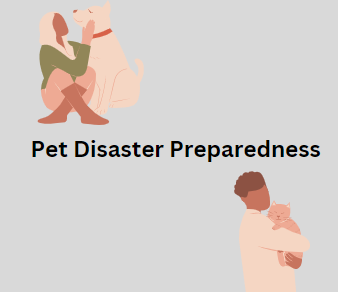| | | Preparing Your PetsPara ver esta pagina en Español haga click aguí

| Pets are a part of your family. They depend on you for their safety and well being. Before an emergency occurs, it’s important that you develop a plan of action specifically for your pets. In the event that a disaster should strike and your family must evacuate, you will need to know ahead of time where your pets will stay and take measures to ensure their safety and care.
KNOW WHERE TO GO
Due to Health and Safety codes not all emergency shelters will accept pets. Kennels often will have very limited space. It may be difficult to find shelter for your animals during the midst of a disaster, so plan ahead. Everyone should keep a list of friends and family, outside of the affected area that could serve as a temporary caregiver. Do research now to identify any hotels and motels that will accept you and your pets. Check for restrictions on size and breeds. Also, keep a list of boarding facilities and veterinarians in your emergency kit.
KEEP MEDICAL RECORDS ON HAND
Many kennels will not take pets without proof of vaccinations, or if a pet is injured or becomes ill during an emergency. Keep your pets medical records on hand to help vets provide better health care.
MAKE SURE PETS WEAR IDENTIFICATION TAGS
If a pet becomes lost or escapes during a state of confusion or evacuation situation, proper ID will increase the chances of a safe return home.
GET A PET CARRIER
An individual carrier for each pet in the family will make transporting pets safely and gives pets a feeling of security. Make sure the carrier is approved for airline travel.
CREATE A “PET PREPAREDNESS KIT”
This kit should contain medical records, bottles of water, extra food, extra blankets, a soft muzzle, collars, leashes, a current photo of your pet, a first-aid kit and a weeks supply of any special medications and dosage instructions.
LEAVING YOUR PET AT HOME
If you must leave your pet at home, make sure to confine your pet in a safe, high area in your home, away from windows and outside walls. Leave water in a sturdy, no-spill container and at least a three-day supply of dry food. You may want to leave a visible note on the outside, listing what animals are inside and where they can be located. Provide a telephone number where you can be reached and also your veterinarian’s number. Never leave your pets together during a disaster even when they are normally friendly. And never leave your pet chained or loose outside.
CARING FOR BIRDS
Birds should be transported in a secure travel cage or carrier. In cold weather, wrap a blanket around the carrier and warm up the car before placing the birds inside. During warm weather, carry a plant mister to mist the bird’s feathers periodically. Do not put water inside of carrier during transportation. Provide a few slices of fresh fruit and vegetables with high water content. Do not let birds out of cages or carriers.
REPTILES
Most snakes can be transported in a pillowcase, but they must be transferred to more secure housing when they reach the destination site. If your snake requires frequent feeding, carry food with you. Take a water bowl large enough for soaking as well as a heating pad. When transporting lizards use the same directions as for birds.
SMALLER PETS
Small mammals such as hamsters, gerbils, etc should be transported in a secure carrier suitable for maintaining the animals while sheltered. Take bedding materials, food bowls, and water bottles. | ![]() | |
| | | |